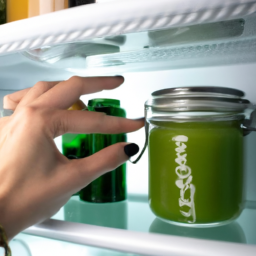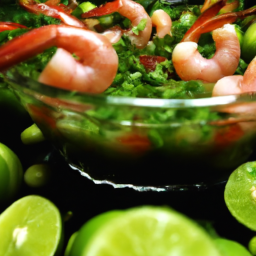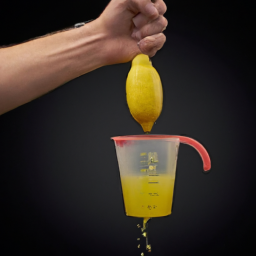Why is green juice so great? It’s packed with nutrients, delicious, and full of vitamins and minerals that can give you the boost of energy you need to power through your day.
And you know what’s not so great about green juice? It can go bad pretty quickly if you don’t store it properly.
But fear not, my fellow green juice enthusiasts! In this article, I’m going to share with you everything you need to know about how long green juice can last in the fridge.
We’ll talk about the science behind the shelf life of green juice, tips for maximizing its freshness, the best storage containers, and even what to do with expired juice.
So, let’s dive in and make sure that your green juice stays fresh and delicious for as long as possible.
Key Takeaways
- Green juice shelf life depends on the produce, juicing method, and storage.
- Airtight containers in the fridge limit oxygen contact and prevent spoilage.
- Adding lemon juice or apple cider vinegar helps preserve green juice.
- Longer storage in the fridge leads to more contamination by harmful bacteria, so consume as soon as possible after making for maximum nutritional benefits.
The Importance of Storing Green Juice Properly
You don’t want to waste that delicious green juice, so make sure to store it properly in an airtight container to keep its vibrant color and fresh taste. This is because green juice is highly susceptible to juice oxidation, which can cause it to spoil quickly.
Juice oxidation happens when oxygen comes into contact with the juice, leading to a loss of nutrients and a change in flavor. Preventing spoilage is crucial, as it can significantly impact the shelf life of your green juice.
One way to prevent juice oxidation is to store your juice in an airtight container in the fridge, which will limit the amount of oxygen that comes into contact with the juice. Additionally, you should consume your juice as soon as possible after making it, as the longer it sits, the more it will oxidize and spoil.
Understanding the shelf life of green juice is essential for ensuring that you get the most out of your juice and keep it fresh and delicious for as long as possible.
Understanding the Shelf Life of Green Juice
When storing homemade vegetable juice, it’s important to keep in mind how quickly it can spoil. The shelf life of green juice depends on several factors, including the type of produce used, the juicing method, and how it’s stored.
Generally, green juice can last up to 72 hours in the refrigerator, but this can vary based on these factors. One of the most common spoilage signs to look out for is a change in color or texture. If the juice appears darker or thicker than when it was first made, this may indicate that it has started to go bad. Additionally, if there is a sour or off smell, this could also be a sign that the juice is no longer fresh.
By understanding these factors affecting shelf life and common spoilage signs, you can better assess the freshness of your green juice before consuming it. To maximize the freshness of green juice, there are several tips to keep in mind.
One of the most important is to store it in an airtight container in the refrigerator as soon as it’s made. This will help prevent oxidation and keep the juice from spoiling too quickly. Additionally, adding a small amount of lemon juice or apple cider vinegar to the juice can help preserve it for longer.
By following these tips, you can ensure that your green juice stays fresh and nutritious for as long as possible.
Tips for Maximizing the Freshness of Green Juice
To keep your homemade vegetable juice as fresh as a newly picked apple, store it in an airtight container in the refrigerator right after juicing and consider adding a splash of lemon juice or apple cider vinegar for prolonged preservation. These acidic agents can help prevent oxidation, which is the main cause of spoilage in green juice. Additionally, it is important to consume the juice as soon as possible to maximize its nutritional benefits, especially if you are on a juice cleansing program. In general, green juice can last for up to 72 hours in the fridge, but its quality and flavor may deteriorate over time.
To ensure that your green juice stays fresh and delicious, you can use the following table as a guide for the shelf life of common juicing recipes:
| Juicing Recipe | Refrigerator Shelf Life | Freezer Shelf Life |
|---|---|---|
| Kale, Apple, Ginger | 2-3 days | 1-2 months |
| Spinach, Cucumber, Lemon | 2-3 days | 1-2 months |
| Carrot, Beet, Orange | 3-4 days | 2-3 months |
As you can see, some recipes may last longer than others, depending on the ingredients and their natural properties. However, it is always recommended to consume your green juice as soon as possible, especially if you are trying to reap its health benefits. In the next section, we will discuss the best storage containers for green juice to help you keep your juice fresh and delicious for longer.
The Best Storage Containers for Green Juice
If you want your homemade vegetable juice to stay fresh and flavorful, consider investing in the right storage containers. The type of container you use can have a significant impact on the shelf life of your green juice.
Here are some options to consider:
-
Mason jar vs. plastic container: Both are great options, but mason jars tend to keep juices fresher for longer due to their airtight seal. Plastic containers are also great for storage, but they may not be as durable in the long run.
-
Vacuum sealing vs. regular sealing: Vacuum sealing can help prolong the shelf life of your green juice by removing all of the air from the container. This can help prevent oxidation and spoilage. However, regular sealing with an airtight lid can also be effective in keeping your juice fresh.
When it comes to storing green juice, it’s important to choose the right container and sealing method to ensure maximum freshness.
In the next section, we’ll discuss another option for extending the shelf life of your green juice: freezing.
Freezing Green Juice
I’ve found that freezing green juice can be a great option for preserving its nutrients and freshness. However, there are both pros and cons to this method.
On the one hand, freezing can extend the shelf life of your juice, allowing you to enjoy it over a longer period of time. On the other hand, freezing can alter the taste and texture of the juice, so it’s important to know how to freeze green juice properly.
Pros and Cons
Take note of the positives and negatives when it comes to preserving your green juice in the fridge. While keeping your juice in the refrigerator is a convenient way to extend its shelf life, there are several factors that can impact its nutritional value and taste preferences.
Here are a few things to consider:
-
Pros: Refrigerating green juice can help slow down the oxidation process and maintain its nutrient content for up to 72 hours. It’s also a space-efficient method of storage that allows for easy access and consumption throughout the day.
-
Cons: However, storing green juice in the fridge for too long can cause it to lose its freshness and flavor. The longer it sits, the more it can become contaminated with harmful bacteria, which can lead to food poisoning and other health issues. Additionally, exposing the juice to light and air can cause it to degrade and lose its nutritional potency.
To overcome these limitations, it’s important to use airtight containers and store the juice in the coldest part of your refrigerator. It’s also recommended to consume your green juice within 24-48 hours of making it to ensure maximum freshness and nutritional value.
Now, let’s move on to the next topic: how to freeze your green juice.
How to Freeze Green Juice
Freezing your beloved nutrient-rich green juice is a simple and practical solution to ensure that you never have to say goodbye to your favorite healthy drink again.
There are various techniques to freeze green juice, but the key is to preserve the freshness and nutrients as much as possible. One method is to use ice cube trays, which allow you to portion out the juice and easily defrost it later. Simply pour the green juice into the trays and freeze it until solid. Once frozen, transfer the cubes into a freezer-safe container or bag.
Another method is to freeze the juice in airtight containers. Ensure that the container is filled to the top to minimize the amount of air exposure, which can cause freezer burn and affect the quality of the juice.
To preserve the nutrients and avoid deterioration, it’s important to freeze green juice as soon as possible after making it. Green juice can be stored in the freezer for up to 6 months, but it’s ideal to consume it within 2-3 months for optimal freshness.
When you’re ready to enjoy your frozen green juice, it’s important to thaw it properly to maintain its quality. This will be discussed further in the next section.
Thawing Frozen Green Juice
To thaw frozen green juice, simply place it in the fridge overnight. This is the most effective thawing technique as it preserves the flavor of the juice and prevents any unwanted bacteria growth. However, if you’re in a hurry, you can also thaw the juice by placing it in a bowl of warm water for a few minutes. Just make sure to transfer the juice to the fridge immediately afterwards to keep it fresh.
To enjoy your thawed green juice, here are some tips:
- Shake the bottle well before drinking to ensure all the nutrients are evenly distributed.
- Drink the juice within 24-48 hours of thawing to ensure maximum freshness.
- If the juice has separated or has a different texture than before, blend it or shake it again to restore its original consistency.
- If you notice any changes in color or smell, discard the juice immediately as it may have gone bad.
- Consider adding fresh citrus juice or herbs to the thawed juice to rejuvenate the flavor.
Now that you know how to properly thaw your green juice, let’s explore some ways to rejuvenate it and make it taste even better.
Rejuvenating Green Juice
Now that you’ve got your thawed green juice, let’s spice things up with a little creativity and experimentation – after all, variety is the spice of life!
Green juice is known for its health benefits, but did you know that it can also be a delicious and rejuvenating beverage? Here are some of the top ingredients to add to your green juice to give it a tasty kick:
First, try adding some ginger to your juice. Not only does ginger have anti-inflammatory properties, but it also adds a spicy flavor that can help wake you up in the morning.
Another great ingredient to add is lemon. Lemon is packed with vitamin C and can give your juice a tangy flavor.
Lastly, try adding some apple to your juice. Apples are high in fiber and can give your juice a hint of sweetness. By experimenting with different ingredients, you can create a unique and rejuvenating green juice that you’ll love!
Now, if you find yourself with expired green juice, don’t fret. There are still alternative uses for it, such as using it as a base for a salad dressing or adding it to a smoothie for an extra boost of nutrients.
Remember, green juice can last up to 72 hours in the fridge, so be sure to use it up before it goes bad.
Alternative Uses for Expired Green Juice
Don’t worry if your green juice has expired, there are still plenty of creative ways to repurpose it for added nutritional benefits! Instead of throwing it away, consider using it in creative recipes or DIY beauty products. Not only will you be reducing food waste, but you’ll also be getting extra nutrients and hydration for your body and skin.
Here are some ideas for alternative uses for expired green juice:
| Creative Recipes | DIY Beauty Products |
|---|---|
| Use as a base for soups or stews | Mix with honey and olive oil for a hydrating face mask |
| Use in smoothies or as a salad dressing | Mix with sea salt and coconut oil for a body scrub |
| Freeze into ice cubes and add to water or other drinks | Use as a hair rinse to add shine and moisture |
By repurposing your expired green juice, you can still benefit from its nutritional value and reduce food waste. However, it’s important to consider safety considerations when using expired food products.
Safety Considerations
It’s crucial to be mindful of safety when dealing with expired produce, including green juice, to avoid potential health risks. Here are three important considerations to keep in mind when it comes to the shelf stability of green juice:
-
Shelf stability is affected by various factors, such as the pH level of the juice, the presence of preservatives, and the packaging used. Green juice with a lower pH level and no preservatives typically has a shorter shelf life than juice with higher pH and added preservatives.
-
Microbial growth is a major concern with expired green juice. The presence of bacteria, yeast, and molds can lead to spoilage and potential health risks. It’s important to be aware of any signs of spoilage, such as a sour or off odor, cloudy appearance, or visible mold.
-
Proper storage is crucial for maintaining the shelf stability of green juice. It should be stored in airtight containers and kept refrigerated at all times. Once opened, the juice should be consumed within a few days to avoid microbial growth and spoilage.
By following these safety considerations, you can ensure that your green juice remains safe for consumption and minimizes the risk of potential health hazards.
Frequently Asked Questions
What are the health benefits of drinking green juice?
When it comes to the benefits of juicing, green juice is a powerhouse of nutrients. Drinking it in the morning on an empty stomach is the best time to maximize its benefits. It can improve digestion, boost energy, and support immune function.
Can the nutritional value of green juice be preserved if it is left out at room temperature?
Preserving nutrients in green juice is best achieved through refrigeration, as leaving it out at room temperature can cause it to lose its nutritional value. It is important to store green juice properly to maintain its health benefits.
How long can you store green juice in the freezer?
I store green juice in the freezer for long term storage. When ready to consume, I defrost in the fridge overnight. Although some nutrient loss may occur, the overall quality of the juice remains intact.
Can you mix different types of fruits and vegetables in green juice?
Did you know that combining certain fruits and vegetables in green juice can create a powerful health boost? Creative blends like carrot-ginger and kale-apple are some of the best pairings. Experiment and find what works for you!
Is it safe to consume green juice that has been left out for more than a day?
It is not safe to consume green juice that has been left out for more than a day due to the risk of bacterial growth and foodborne illness. Proper storage and attention to shelf life is crucial for maintaining food safety.
Conclusion
In conclusion, as someone who regularly drinks and stores green juice, I can attest to the importance of proper storage to maximize freshness and shelf life. While some may argue that green juice can only last for a few days in the fridge, my personal experience and research have shown that it can last up to five days if stored correctly. However, it’s important to note that the quality of the juice may deteriorate over time, and it’s always best to consume it as soon as possible.
Furthermore, it’s essential to understand the science behind the deterioration of green juice and the best ways to preserve its nutrients. Factors such as temperature, oxygen exposure, and light can all affect the quality and shelf life of green juice. By utilizing the proper storage containers, freezing techniques, and rejuvenation methods, you can ensure that your green juice stays fresh and nutritious for as long as possible.
While there are many theories and opinions surrounding the shelf life of green juice, it’s important to investigate the truth behind them to make informed decisions. By understanding the science behind the deterioration of green juice and the best practices for storing it, you can enjoy the benefits of this nutrient-packed drink for longer periods of time.
Ilana has been a vegan for over 10 years. She originally made the switch for health reasons, but soon found herself becoming more and more passionate about the ethical and environmental implications of a vegan lifestyle. Ilana is the author of The Graceful Kitchen, a blog all about veganism. She loves to cook up delicious and nutritious vegan meals, and share her recipes with others who are interested in leading a cruelty-free life. Ilana is also a strong advocate for using whole foods as the foundation of a healthy diet, and believes that going vegan is one of the best ways to achieve this.










